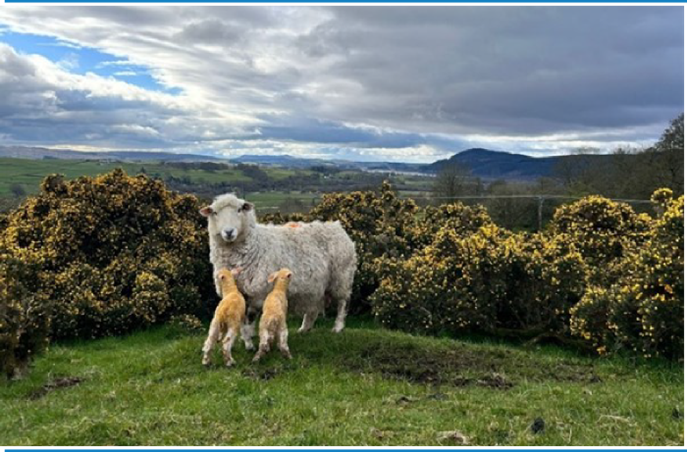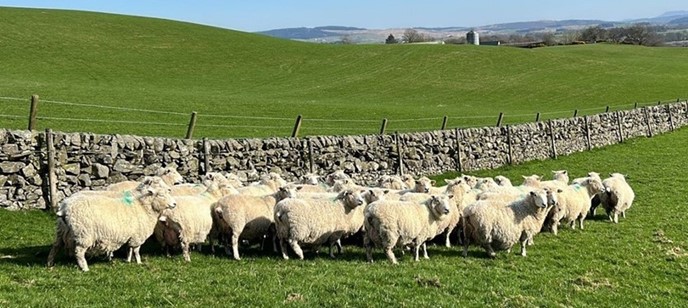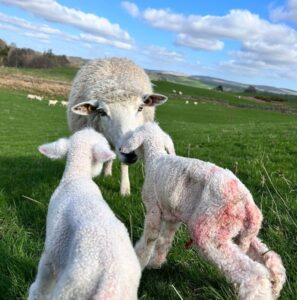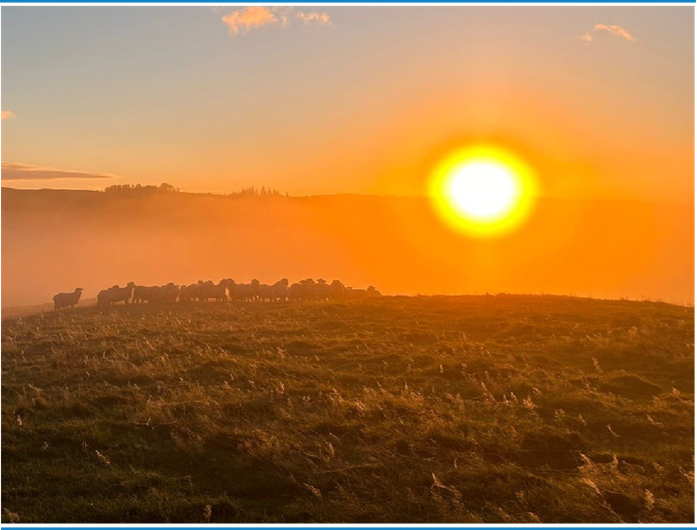Sustainable Sheep Systems: Viewfield Case Study
15 September 2023Read how the Maxwell family at Viewfield have developed a sustainable low input productive flock through a focus on functional genetics and production off forage.
The Maxwell family, Marcus, Kate and son Murphy, farm 2,100 ac (850 ha) of grassland at Viewfield and neighbouring units, alongside 900 ac (364 ha) on tenancy at a hill unit 6 miles away.
The business runs 2,800 New Zealand Romney ewes which are run on a forage based system and lambed outdoors in April. Thirty shearling rams are sold off farm each year alongside a strong demand for breeding females. All wethers and surplus ewe lambs are finished on-farm by November each year.
In addition 120 outdoor spring calving Luing cows are run, all bred pure apart from heifers which go to high index Angus bulls. Calves are weaned in February and sold in the spring.
Breeding
The Viewfield New Zealand Romney flock was established in 1996 with importation of four tups and 40 females as well as embryos. Semen has since been imported every few years to bring in the best performance recorded genetics from New Zealand.
“One of my main philosophies is to keep the job enjoyable, every time stock are in the pens, to think, how we can reduce mundane tasks.” - Marcus Maxwell.
The business runs an elite flock of 200 performance recorded stud ewes. Lambs are DNA sampled for parentage, weights recorded and stock selected on genomic breeding values (eBVs) from Sheep Improvement Limited (SIL) in New Zealand. Whilst recording has ceased since the start of Covid, the business plans to restart full performance recording in 2024.
From the outset, breeding has been focused on robust efficient maternal ewes that lamb themselves outdoors and maintain condition on a forage-based system while achieving strong performance.
Only twin ewe lambs are retained for breeding. The aim being to optimise scanning for an outdoor lambing system at ~180%, avoiding excessive triplet numbers which are sold at scanning. Strong lamb survival means the flock is consistently rearing +150%.
The flock is selected for improved lamb growth rates with a focus on improving muscle and optimising fat cover with the aim of having a lamb that can kill out at a range of weights. The flock is currently averaging 18.5kg dwt.
A strict culling policy is adopted for welfare and labour traits. Ewes and lambs that require assistance at lambing are tagged with a red cull tag. Years of selection have paid off with only five ewes (0.2%) assisted in 2023.
A zero tolerance culling policy has been adopted, with lame ewes treated, and put into a cull field. For the last few years whilst flock numbers are built up, a two-strike policy has been adopted instead with ewes spray marked and culled if they don’t improve or get lame again.

Lambing to Tupping
Ewes are put onto lambing fields at the start of April, at which point supplementation is ceased, to start lambing a week later on the 8th of April. Ewes are checked once or twice each day over lambing.
Ewes and lambs are set stocked to weaning in late July at 100 days. Early weaning allows lambs to be given priority grazing with ewes on clean up duty behind lambs or on rougher grazing. Cows and calves are also an important grazing management tool, resetting pastures that have got away from sheep.
Lambs are finished on the best pastures, including 80 ac of red clover leys to promote lamb performance, with some strategic use of creep feeding depending on pasture quality and availability. In 2022, 450 ewes were put to New Zealand Texels to provide greater flexibility to sell store lambs and to target a keen market for RomTex ewe lambs.
Post-weaning, ewes are run in large mobs of up to 1,000 ewes and moved on a rotational system. This increased grazing pressure allows fields to be evenly grazed out to reset pasture quality for finishing lambs and the following spring, whilst providing rest to promote grass growth for tupping and a staggered shut off before winter for improve spring grass growth.
Thin ewes are run separately on better pasture post-weaning. Those that don’t gain condition by 2nd shearing in September are culled. Ewes are tupped in groups of around 500, at one tup to 100 ewes for 26-27 days.
Wintering Strategy
Post-tupping, ewes continue grazing in large mobs. With the improved pasture utilisation, ewes are still on grazing through into mid-late January with considerable cost savings.
Over half the ewes (1,500) will move onto 100 ac of kale through until the end of February. The rest on a mixture of pasture grazing or silage fed on the hill with deferred grazing. All ewes are on silage or grazing in March and fed a small quantity of concentrates for the last month of pregnancy to promote colostrum quality and milk yield.

Gimmers are run separately to mature ewes to reduce competition and promote performance.
Approximately 1,000 hoggs are wintered in groups on kale, silage or grazing and trained to eat concentrates.
Soil and Pastures
Looking to further promote stock performance, address mineral issues and improve pasture feed quality as well as reduce reliance on bagged fertiliser, the business is taking a ground up approach looking at improving soil health, seeding in more diverse swards and using alternative fertiliser products.
Comprehensive soil analysis has led to targeted lime and trace element applications. Whilst seaweed-based applications are being trialled as an alternative to bagged fertiliser to promote soil and pasture health.

In addition to the 80 ac of red clover, the business has over-seeded 100 ac with white clover in 2023 to reduce reliance on bagged fertiliser (N fixation) and improve sward feed value to promote stock performance.
In 2023, 50 ac has also been over-seeded with a herbal ley mix with more diverse grasses, legumes and herbs included to benefit from improved feed quality, anthelmintic properties, improved sward mineral content and drought tolerance.
Sustainability
| What makes a sheep system sustainable? | At Viewfield |
|---|---|
| Profitability, without reliance on support payments. Continued re-investment and ability to scale if required to maintain profitability | Low input forage based system achieving moderate output to promote profitability. A focus on profit per ha. Breeding for profit-driving traits, not aesthetics. Management and breeding system focussed on low labour per ewe to reduce labour costs and facilitate continued growth in flock size. |
| Reduced reliance on purchased inputs that may become unavailable or not cost-effective. | Matching outdoor lambing with grass growth, effec- tive grassland management, forage crops and robust genetics to reduce concentrate supplementation. Focus on soil fertility, clover and diverse swards to reduce reliance on bagged fertiliser. |
| Sustainable parasite control – limiting development of drug resistance. | Test and treat approach using FEC. FEC reduction tests to assess wormer efficacy. Herbal leys to benefit from anthelmintic properties. |
| Maintain and regenerate our greatest asset – soil. | Focus on soil health, alternative products to replace inorganic fertilisers, and diverse swards combined with effective grazing management. |
| Maintain market access and social acceptance. | Proud supporters of lamb and wool. Breeding for welfare traits. Strong emphasis on environment and conservation as well as animal welfare and behaviour. |
| Attract and retain the next generation | Succession planning. Developed a low labour system and genetics for im- proved work life balance. Investment into technology and new ideas, e.g. six- way auto drafter, to improve labour efficiency and keep things interesting. |
Author: Daniel Stout, SAC Consulting.
With thanks to the Maxwell family, Viewfield. Credit for all photos to Murphy Maxwell.
For more outputs from the project visit: FAS Sustainable Sheep Systems
Sign up to the FAS newsletter
Receive updates on news, events and publications from Scotland’s Farm Advisory Service

